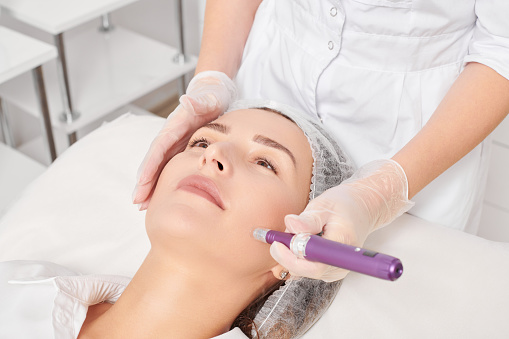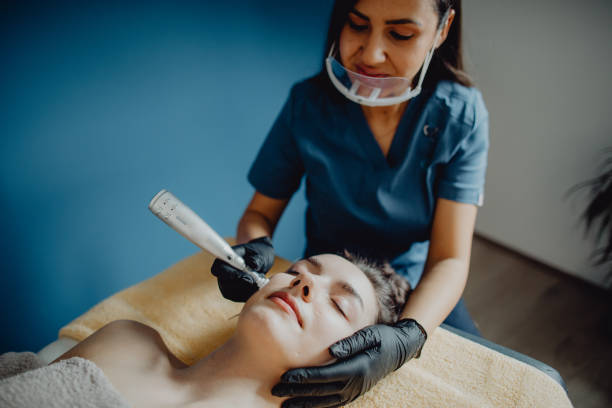Microneedling is a cosmetic treatment that involves using a device containing tiny needles to create small punctures in the skin. These punctures stimulate the body’s natural healing process, leading to a number of benefits for the skin.
Some of the benefits of microneedling include:
- Improved skin texture: Microneedling can help to reduce the appearance of fine lines, wrinkles, and scars, leading to smoother, more even skin texture.
- Increased collagen production: The punctures created during microneedling stimulate the production of collagen, a protein that gives skin its elasticity and firmness.
- Reduced hyperpigmentation: Microneedling can help to reduce the appearance of dark spots and hyperpigmentation, leading to a more even skin tone.
- Enhanced product absorption: The tiny punctures created during microneedling can help topical skincare products to penetrate deeper into the skin, increasing their effectiveness.
- Reduced pore size: Microneedling can help to reduce the size of pores, leading to a smoother, more refined complexion.
Overall, microneedling can be a highly effective way to improve the appearance and health of your skin. However, it’s important to note that the treatment may not be suitable for everyone, and it’s always best to consult with a qualified skincare professional before undergoing any cosmetic treatment.

How much does microneedling cost?
The cost of microneedling can vary depending on several factors, including the location, the provider’s experience and expertise, and the specific type of microneedling treatment being performed.
On average, a single microneedling session can cost anywhere from $100 to $700 or more, depending on the provider and the location. However, many providers offer package deals or discounts for multiple sessions, which can help to reduce the overall cost.
It’s important to note that microneedling is often considered a cosmetic procedure, which means that it may not be covered by insurance. Additionally, some providers may charge extra fees for additional treatments or add-ons such as numbing cream or post-treatment skincare products.
It’s always a good idea to research different providers and compare prices and reviews before choosing a microneedling provider. Additionally, it’s important to make sure that the provider is licensed and experienced in performing microneedling procedures, as this can help to ensure that you get the best results possible.
Are there any risks or side effects?
Yes, microneedling, including when done under the eyes, can have potential risks and side effects, although these are generally mild and temporary when the procedure is performed correctly by a trained professional. Here are some possible risks and side effects:
1. Redness and Swelling
- Description: After the procedure, it’s common to experience redness, similar to a mild sunburn, and slight swelling in the treated area. This usually subsides within a few hours to a day.
- Risk: This is a normal reaction and typically goes away quickly with proper aftercare.
2. Bruising
- Description: The area under the eyes is delicate, and bruising can sometimes occur after microneedling due to the gentle pressure applied to the skin.
- Risk: Bruising is usually minor and resolves within a few days. It can be minimized by choosing a skilled practitioner who uses appropriate needle lengths.
3. Skin Irritation
- Description: The skin may feel tight, dry, or sensitive for a few days following the treatment.
- Risk: While irritation is common, it can usually be managed with hydrating products and following the professional’s aftercare instructions.
4. Infection
- Description: Since microneedling involves tiny punctures in the skin, there’s a small risk of infection if the procedure or aftercare is not properly managed.
- Risk: This is rare, but it can occur if the skin is not kept clean or if there’s exposure to bacteria after the treatment. Using sterile equipment and following the aftercare guidelines minimizes this risk.
5. Hyperpigmentation or Hypopigmentation
- Description: In rare cases, microneedling can cause changes in skin pigmentation, either making the skin darker (hyperpigmentation) or lighter (hypopigmentation). This can be more common in individuals with darker skin.
- Risk: This is generally temporary but can be more prominent in people with darker skin tones. A professional who understands skin types can help minimize the chances of this occurring.
6. Scarring
- Description: While microneedling is usually safe, improper technique, excessive needle depth, or insufficient aftercare can lead to scarring, though this is uncommon.
- Risk: The risk is higher if you try to perform microneedling at home or use improper equipment. It’s best to leave it to professionals.
7. Allergic Reactions
- Description: If any topical serums or products are applied during or after the treatment, there’s a small chance of an allergic reaction, particularly in sensitive areas like under the eyes.
- Risk: Patch testing any products used during the procedure can help prevent this.
8. Pain or Discomfort
- Description: Although microneedling is generally well-tolerated, some people experience discomfort or pain during the treatment, especially in sensitive areas.
- Risk: Topical numbing creams are often used to reduce discomfort during the procedure.
9. Delayed Healing
- Description: Microneedling stimulates skin regeneration, which can sometimes take a few days to weeks. In some individuals, healing may be slower, especially if the skin is more sensitive or prone to conditions like eczema.
- Risk: Delayed healing can also result from improper aftercare or if the treatment is done too frequently.
Minimizing Risks:
- Choose a Skilled Practitioner: It’s crucial to seek treatment from a licensed, experienced professional who is skilled in microneedling, especially in delicate areas like under the eyes.
- Aftercare: Follow post-treatment care instructions carefully, such as avoiding sun exposure, using hydrating products, and keeping the skin clean to prevent infection.
- Avoid Certain Conditions: Microneedling should be avoided if you have active skin conditions like eczema, rosacea, or active acne.

Microneedling is a minimally invasive cosmetic procedure that uses a small device called a dermaroller or a microneedling pen to puncture the skin with tiny needles to induce collagen production and improve the appearance of scars, fine lines, wrinkles, and uneven skin texture. Here’s a general procedure for microneedling:
- Consultation: Before getting microneedling, it’s important to consult with a dermatologist or licensed aesthetician to determine if you’re a good candidate for the treatment and discuss any potential risks or complications.
- Preparation: The skin should be clean and free of makeup, sunscreen, or any other products before the procedure. The provider may apply a numbing cream or a topical anesthetic to minimize any discomfort during the procedure.
- Microneedling: The provider will use a dermaroller or a microneedling pen to create small punctures on the skin’s surface. The device will be moved across the treatment area in a crisscross pattern to ensure that the entire area is treated evenly.
- Post-treatment care: After the microneedling procedure, the skin may be red, swollen, or slightly sensitive. The provider may apply a calming serum or a mask to soothe the skin and reduce inflammation. It’s important to avoid applying makeup or any other products for the first few hours after the treatment and to avoid direct sun exposure for the next few days.
- Recovery: The recovery period can vary depending on the depth of the needles used and the individual’s skin type. It’s important to follow the provider’s instructions for aftercare, including avoiding strenuous exercise or activities that can cause sweating and avoiding hot showers or baths.
- Follow-up treatments: Microneedling is typically done in a series of treatments spaced out several weeks apart, depending on the individual’s needs and goals. The provider will recommend a treatment plan based on the individual’s skin type and concerns.
It’s important to note that the above procedure is a general guideline, and the specifics may vary depending on the individual’s skin type, the device used, and the provider’s technique. It’s important to consult with a licensed professional to determine the best course of action for your specific needs.
